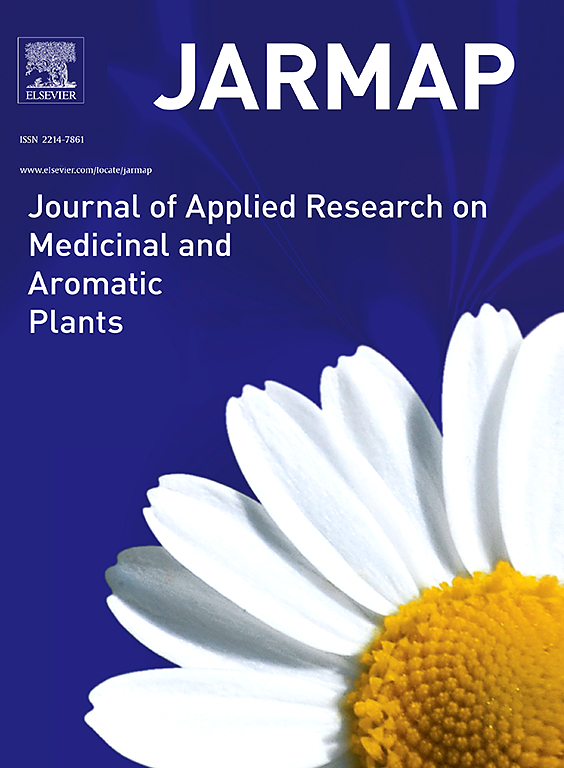Accurate and intelligent quantification of adulterated Angelicae Sinensis Radix by a novel ensemble method with near-infrared spectroscopy
IF 3.6
2区 农林科学
Q1 PLANT SCIENCES
Journal of Applied Research on Medicinal and Aromatic Plants
Pub Date : 2025-04-01
DOI:10.1016/j.jarmap.2025.100640
引用次数: 0
Abstract
The integrity and authenticity of Chinese medicinal materials are essential for ensuring the efficacy of medicines and safety of patients. Angelicae Sinensis Radix (ASR), a highly valued traditional Chinese medicine (TCM), is often substituted or mixed with lower-cost alternatives. In this study, a novel method was proposed for the quantification of adulterated ASR using near-infrared (NIR) spectroscopy combined with chemometrics. Binary and ternary adulterated ASR samples were prepared by mixing ASR with Angelicae Pubescentis Radix (APR) and Chuanxiong Rhizoma (CR), and their NIR spectra were measured in the range of 1000–1800 nm. Sample subsets were initially selected using Monte Carlo (MC) sampling, followed by the application of whale optimization algorithm (WOA) to select variables and establish an extreme learning machine (ELM) model, referred to as MC-WOA-ELM. The iteration number and percentage of training subsets for MC-WOA-ELM were optimized to further improve the predictive performance of model. The predictive ability of the proposed method was compared with partial least squares (PLS), ELM and WOA-ELM for both binary and ternary adulterated ASR samples. The results indicate that MC-WOA-ELM achieves the highest prediction accuracy. Therefore, the proposed method is rapid and intelligent for the quantification of adulterated ASR samples.
新型近红外光谱系综法准确智能定量掺假当归
中药材的完整性和真实性对保证药品的疗效和患者的安全至关重要。当归(Angelicae Sinensis Radix, ASR)是一种价值很高的中药,经常被替代或与较低成本的替代品混合使用。本研究提出了一种利用近红外光谱与化学计量学相结合的方法来定量掺假ASR。将ASR与短毛当归(APR)和川芎(CR)混合制备二元和三元掺假ASR样品,并在1000 ~ 1800 nm范围内测定其近红外光谱。首先采用蒙特卡罗(Monte Carlo, MC)采样方法选择样本子集,然后应用鲸鱼优化算法(whale optimization algorithm, WOA)选择变量,建立极限学习机(extreme learning machine, ELM)模型,简称MC-WOA-ELM。对MC-WOA-ELM的训练子集迭代次数和百分比进行优化,进一步提高模型的预测性能。将该方法与偏最小二乘(PLS)、ELM和WOA-ELM对二元和三元掺假ASR样品的预测能力进行了比较。结果表明,MC-WOA-ELM预测精度最高。因此,该方法具有快速、智能化的特点,可用于ASR掺杂样品的定量分析。
本文章由计算机程序翻译,如有差异,请以英文原文为准。
求助全文
约1分钟内获得全文
求助全文
来源期刊

Journal of Applied Research on Medicinal and Aromatic Plants
Pharmacology, Toxicology and Pharmaceutics-Drug Discovery
CiteScore
6.40
自引率
7.70%
发文量
80
审稿时长
41 days
期刊介绍:
JARMAP is a peer reviewed and multidisciplinary communication platform, covering all aspects of the raw material supply chain of medicinal and aromatic plants. JARMAP aims to improve production of tailor made commodities by addressing the various requirements of manufacturers of herbal medicines, herbal teas, seasoning herbs, food and feed supplements and cosmetics. JARMAP covers research on genetic resources, breeding, wild-collection, domestication, propagation, cultivation, phytopathology and plant protection, mechanization, conservation, processing, quality assurance, analytics and economics. JARMAP publishes reviews, original research articles and short communications related to research.
 求助内容:
求助内容: 应助结果提醒方式:
应助结果提醒方式:


